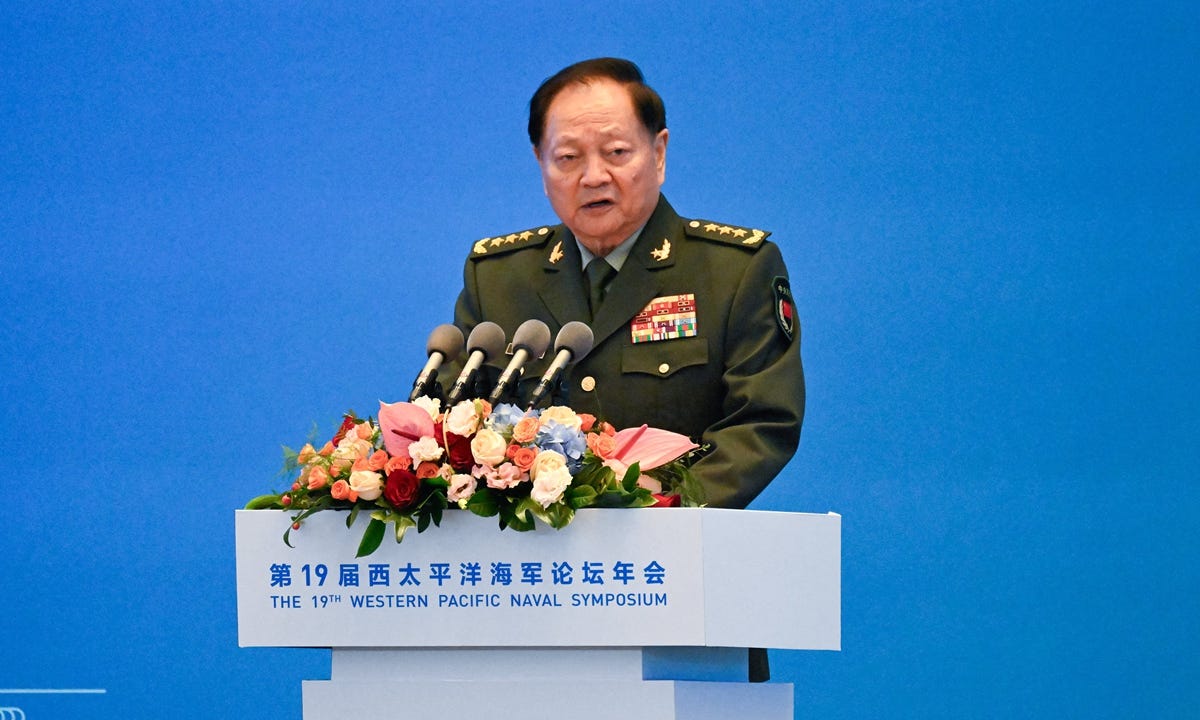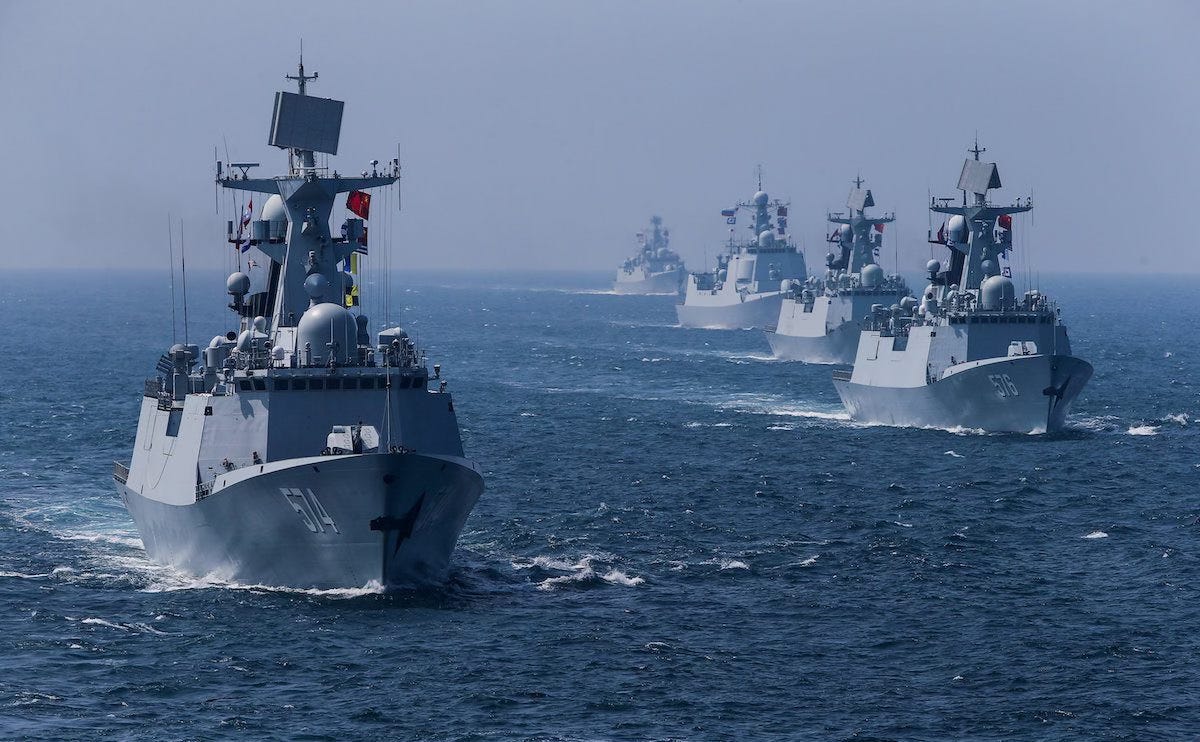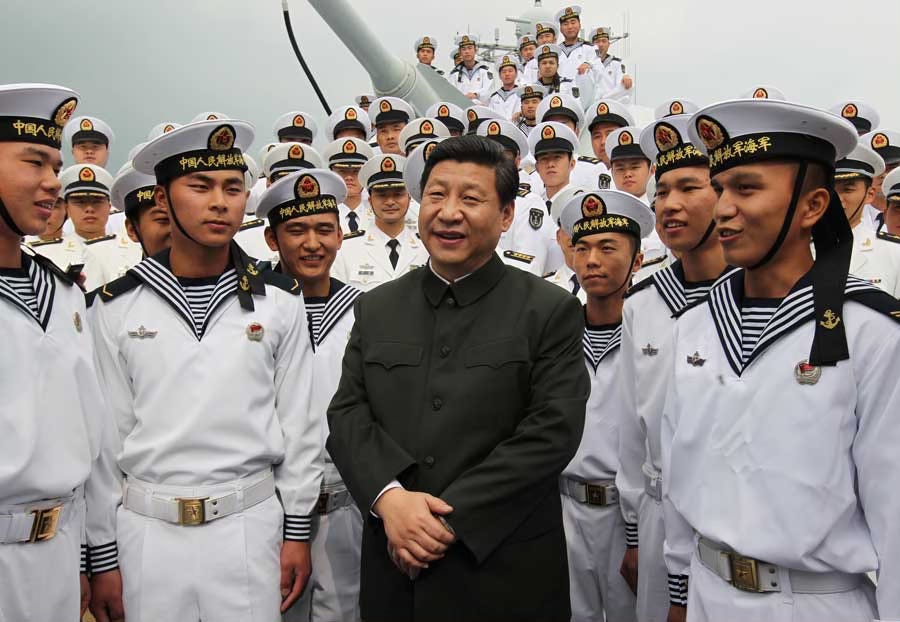Naval Manoeuvres
Qingdao Hosts Western Pacific Naval Symposium, PLA Navy global influence grows, China's Military Diplomacy, China Shipbuilding Eclipses USA

Qingdao Hosts Western Pacific Naval Symposium
By Yang Sheng in Beijing and Guo Yuandan in Qingdao
Senior naval officers from around the world on Monday witnessed the opening of a naval symposium in China which is aimed at bridging differences and seeking global governance on maritime issues, while a senior Chinese defense official reaffirmed China's commitment to resolving disputes with directly involved countries through friendly consultation, but also vowed "countermeasures" against unwarranted provocations.
The 19th Western Pacific Naval Symposium (WPNS) opened on Monday in the port city of Qingdao in East China's Shandong Province. Zhang Youxia, vice chairman of the Central Military Commission, attended the event and delivered an address, the Xinhua News Agency reported.
Zhang said that China's armed forces have actively participated in international cooperation of maritime security and provided maritime public security goods, adding that China will play a more positive and open role in international military cooperation.
"We should resolutely abandon the Cold War mentality, join hands to create peace and stability, bridge differences through dialogue and consultation, jointly discuss and establish rules for governance, and push maritime security governance to a new level with practical results."
China has been committed to resolving maritime disputes peacefully through friendly consultation with countries directly concerned, but it will safeguard its legitimate rights in the face of deliberate violation of its sovereignty and it will take firm countermeasures against unreasonable provocations, he said.
"We will not make trouble and will not be afraid of trouble. China's armed forces will resolutely safeguard national unity and interests," said Zhang.
Platform for talks
The biennial meeting, attended by naval commanders and delegates from around the world, themed "Oceans with a Shared Future" this year, and the four-day meeting will sea the participation of over 180 navy representatives from 29 countries.
This is the second time the WPNS was held in China after the country first hosted the event in 2014.
Delegates to the meeting will review activities taking place under the symposium's framework since its 18th biennial meeting, set the future agenda, and discuss and vote on issues such as the WPNS Business Charter, the Code for Unplanned Encounters at Sea (CUES), and unmanned systems, Xinhua reported on Sunday.
Foreign naval leaders will be invited to discuss the Global Security Initiative and maritime peace, maritime order based on maritime security cooperation and international laws, and global maritime governance.
Liang Wei, a senior officer with China's Naval Research Academy (NRA), said the attendance at this meeting and the ranks of participating officers from other countries are high. "This not only demonstrates the vigor of the symposium but also reflects the influence and appeal of the Chinese navy," Liang said, Xinhua reported.
Reuters reported on Monday that "The symposium is a rare opportunity for countries with opposing regional interests to exchange views. Pacific Fleet Commander Admiral Stephen Koehler is attending from the US. Other delegations include Australia, France, India, Russia and Britain."
The Global Times reporters at the symposium found that media outlets were very keen to interview US delegates, but unfortunately representatives of the US navy refused to answer any questions.
Drills in South China Sea
On the same day of the opening of the WPNS, thousands of Philippine and American troops kicked off their annual Balikatan or "shoulder to shoulder" military exercises in the Philippines on Monday, the VOA reported on Sunday, adding as a pretext that "Beijing's growing assertiveness in the region raises fears of a conflict."
Chinese analysts said on Monday that there was no conflict at all in the region during the time of former Philippine president Rodrigo Duterte, and after the current regime in Manila took office, President Romualdez Marcos Jr, due to meddling from the US, has abandoned the "gentlemen's arrangement" that his predecessor reached with China that ensured peace and stability in the region. This is the real cause of the current tension, not China's "growing assertiveness," as China's stance and sincerity on managing the disputes has remained the same.
The US-Philippines drills will be concentrated in the northern and western parts of the archipelago nation, "near the potential flashpoints of the South China Sea and Taiwan," the VOA reported.
Xu Liping, director of the Center for Southeast Asian Studies at the Chinese Academy of Social Sciences, told the Global Times on Monday that there is no doubt that the role the US played in the region is destructive and harmful, and Washington is a troublemaker and provocateur disrupting peace and stability there. "The US' policy in the region will one day backfire, as instability is not in line with US interests either."
The US is using regional disputes to legitimize its military presence in the region, and for Washington, the Philippines is "just a pawn on the chessboard," and if the US provokes a direct military conflict with China, the US fleets and military forces can simply walk away if the situation takes an undesirable turn, but the Philippines will stay where it is, and this is why no other regional countries want to be used by the US, said a Chinese military expert and attendee of the WPNS who asked for anonymity, urging Manila to realize the consequences as soon as possible.
In response to why the Philippines did not attend the 19th WPNS, Liang, the senior officer with the NRA, told media on Monday that "China, as a member of the WPNS, has invited the other 29 member countries and observer states and China is not aware of the specific reasons why the Philippine Navy did not participate in this forum."
Read more here.
PLA Navy global influence grows
By Global Times
The 19th biennial meeting of the Western Pacific Naval Symposium (WPNS) was being held in Qingdao, Shandong Province, from Sunday to Wednesday. More than 180 foreign delegates from 29 countries, including major naval (maritime) defense leaders from 20 countries, attended. US Pacific Fleet commander Stephen Koehler and Russian navy chief Alexander Moiseev led their respective delegations. This year marks the 75th anniversary of the founding of the Chinese People's Liberation Army's (PLA) Navy. As a force of peace, civilization, and strength, the PLA Navy's global influence and appeal continue to grow. The high level of participation and representation of delegations at this year's meeting is a concrete manifestation of this influence.
The WPNS is a regional naval cooperation mechanism platform. After more than 30 years of development, it has become the regional naval multilateral cooperation mechanism that has produced the most achievements, the most vitality, and the greatest potential. China is one of the founding members of the mechanism, and this year, the PLA is hosting the WPNS again after a 10-year hiatus, with the theme "Seas of Shared Future" and three subtopics: the Global Security Initiative and maritime peace, maritime order based on maritime security cooperation and international laws, and global maritime governance. These three subtopics are a concrete manifestation of China's concept and practice of a shared destiny of the oceans. Through cooperation between the Chinese Navy and other countries, it aims to uphold maritime peace and security and address maritime threats and challenges.
Being one of the most important maritime areas in the world, the Western Pacific region consists of several crucial straits and waterways that play a significant role in global trade and maritime traffic. The region is rich in islands and marine resources, involving the interests of many countries. Especially in areas with maritime disputes, preventing accidental conflicts, achieving common development, and ensuring regional security and maritime safety are common concerns for countries in the region. Peace is a key word of this year's symposium and echoes the sentiments of most countries in the region. Particularly, in situations where some countries outside the region frequently engage in provocative military actions, maintaining regional peace and stability is not merely the responsibility of one or two nations but requires collective efforts from all countries in the region. The hosting of this year's symposium by China is with such profound considerations and responsibilities.
China has always been straightforward in its actions, committed to peace without merely relying on diplomatic rhetoric. According to the agenda, this symposium will discuss and vote on issues such as the WPNS Business Charter, the Code for Unplanned Encounters at Sea, Disaster Response Guide, and the unmanned system, aiming to provide guidance for reducing maritime military tensions in response to new changes. In order to ensure the success of the symposium, China has done a lot of preparatory work in advance. An observation from the symposium is that all member states expressed gratitude to the Chinese Navy for hosting the meeting in their speeches. Stephen Koehler, in his speech, also first expressed this gratitude towards China, while stating that the WPNS has provided an opportunity for naval leaders from various countries to communicate.
Foreign media have noticed that the Philippines did not send representatives to this symposium. In response, Chinese experts attending the meeting stated that as the host country of this year's meeting, China extended invitations to all member states and observer countries and was not aware of the specific reasons for the Philippines' absence. The Philippines' unexplained absence is indeed puzzling. However, the same day as the symposium convened, the US and the Philippines launched the largest-ever Balikatan or "Shoulder-to-Shoulder" joint military exercise. Philippine military personnel even claimed that "the purpose of armed forces, why we exist, is really to prepare for war," and "there is no sugarcoating it." These statements clearly imply something, but regional countries have no time to speculate, let alone indulge them. The tide of history is here, and one or two countries cannot shake the collective efforts of the region to maintain maritime peace and tranquility.
This symposium also serves as a platform to showcase the growth and confident image of the Chinese Navy to the outside world. A major nation must have a strong navy; this is a profound lesson drawn from modern Chinese history. Over the past 75 years, the PLA Navy has grown from nothing to become a fully-fledged strategic military branch with comprehensive capabilities, including nuclear and conventional arms. It is accelerating its progress towards the goal of becoming a world-class navy in all aspects. Regardless of whether certain countries are willing to acknowledge it, this trend is unstoppable.
Meanwhile, the powerful Chinese Navy serves as a guardian of world peace and important stabilizing force in the current regional situation. The presence of representatives from so many countries at this symposium, gathering to discuss topics dedicated to achieving peace, precisely demonstrates this point. We also hope that countries can make good use of this platform to promote mutual understanding and trust, transcend differences in safeguarding regional and global maritime peace and stability, and collectively compose a new chapter in maritime civilization.
Read more here.
China's Military Diplomacy in 2023
By Jie Gao and Kenneth W. Allen
US Naval War College
China Maritime Report No. 37: Re-Engaging With the World
China’s military diplomacy plays a crucial role in advancing the nation's foreign policy objectives and safeguarding its strategic interests. This report highlights a diverse array of activities within military diplomacy, including senior-level meetings, joint military exercises, naval port calls, UN peacekeeping operations, and academic exchanges. Our findings reveal a significant—but incomplete—recovery in China's military diplomacy activities in 2023, following a period of reduced contacts with foreign militaries during the COVID-19 pandemic. Southeast Asia and Russia remain primary partners for China, with emerging strategic importance also seen in Africa, Oceania, and the Middle East. Overall, China's military diplomacy underscores its efforts to diversify partnerships and assert its global influence, emphasizing regional stability and international cooperation in pursuit of its diplomatic goals.
China Shipbuilding Eclipses USA
By Ritu Sharma
Chinese People’s Liberation Army – Navy (PLA-N), the world’s largest, has been growing feverishly, leaving India and the US far behind in terms of ship construction capability.
The pace with which the PLA-N inducts warships has often been likened to “dumping dumplings into soup broth.” A leaked US Navy Intelligence presentation slide estimates the Chinese shipyard’s construction capacity is 232 times more than the US shipbuilding prowess.
Sometime between 2015 and 2020, China overtook the US in the number of warships in its fleet, and the gap between the two navies has been fast growing. The Pentagon’s annual report to the US Congress on Chinese military and security developments estimates that the Chinese Navy had 350 warships compared to 293 warships in the US Navy battle force.
The yawning gap of 60 hulls between the two navies is expected to grow every five years until 2035 when China will have an estimated 475 naval ships compared to 305-317 US warships.
The slide published by Fox News shows that Chinese shipyards have a capacity of about 23.2 million tons compared to less than 100,000 tons in the US, making Chinese shipbuilding capacity more than 232 times greater than that of the US.
The slide also shows the “battle force composition” of the countries’ two navies side-by-side, which includes “combatant ships, submarines, mine warfare ships, major amphibious ships, and large combat support auxiliary ships.”
Another section of the slide estimates the percentage each country allocates to naval production in its shipyards. China garners roughly 70 percent of its shipbuilding revenue of naval output, compared to about 95 percent of American shipbuilding revenue.
The US Department of Defense did have the foreboding of this development. Retired Admiral Phil Davidson, former commander of Indo-Pacific Command, predicted in 2021 that the following six years would see China’s threat to naval forces reach its height.
The growing maritime prowess of the PLA-N commensurate with its aggressive hunt for more overseas bases after Djibouti on the Horn of Africa, Karachi and Gwadar in Pakistan, and now possibly Ream in Cambodia to overcome the choke points in the Indian Ocean Region and the larger Indo-Pacific.
The need for China to project power beyond its maritime borders has created a robust shipbuilding capability. Over the last ten years, China has inducted as many as 150 warships.
Apart from the warships in the Chinese Navy, it also has the force of its coast guard and maritime militia fleets. All these sea fleets are the world’s largest numerically, cumulatively accounting for over 700 ships even by conservative estimates.
New ships are being put to sea at an impressive rate, with experts comparing it to “dumping dumplings into soup broth.” Between 2017 and 2019, China reportedly built more vessels than India, Japan, Australia, France, and the United Kingdom combined. Germany’s Vice Admiral Kay-Achim Schonbachsaid noted in 2021 that China’s navy is expanding by roughly the equivalent of the entire French navy every four years.
In 2021, China commissioned at least 28 warships, while the US Navy was positioned to commission seven warships that year. Should China continue to commission warships at a similar rate, it could have 425 battleforce ships by 2030.
On the other hand, the US Navy is reducing its fleet. According to an Association of the United States Navy report at the beginning of 2023, President Joe Biden’s proposed fiscal year 2023 budget called for reducing 15 vessels from the Navy’s fleet. While the proposal allowed funding to build nine new warships, it also proposed decommissioning 24 ships, reducing the fleet. Biden’s fiscal year 2024 budget also called for eliminating 11 warships.
The opacity of the Chinese system makes it difficult to arrive at a definitive number. However, the civil-industrial system has supported the world’s largest shipbuilding industry by funding facilities, training, employing, and rotating workers. Chinese commercial shipbuilding subsidizes and supports military shipbuilding efforts.
Chinese Shipbuilding Growing Both In Capacity, Capability
Chinese shipyards completed the first indigenously built aircraft carrier in a record three years, one month, and seventeen days from the ground up. This is the shortest time, post-World War II, taken by any nation to build an aircraft carrier.
China has achieved this in its very first iteration of a home-grown carrier. In comparison, the United Kingdom, with a solid maritime and shipbuilding history, built Queen Elizabeth II in approximately six years (as the ship was built in mega blocks at different yards, an exact date of keel laying is challenging to arrive at). China is now constructing a third aircraft carrier.
The Chinese success in synergizing civil-military shipbuilding has borne fruit. It is similar to many other critical industries in China, where military and civilian development go hand in hand. By prioritizing the military sector, Chinese shipyards enjoy better funding and rapid turnover. Now, the vessels constructed in Chinese shipyards are getting more sophisticated.
Read more here.










